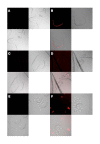Expression profiling and cross-species RNA interference (RNAi) of desiccation-induced transcripts in the anhydrobiotic nematode Aphelenchus avenae
- PMID: 20085654
- PMCID: PMC2825203
- DOI: 10.1186/1471-2199-11-6
Expression profiling and cross-species RNA interference (RNAi) of desiccation-induced transcripts in the anhydrobiotic nematode Aphelenchus avenae
Abstract
Background: Some organisms can survive extreme desiccation by entering a state of suspended animation known as anhydrobiosis. The free-living mycophagous nematode Aphelenchus avenae can be induced to enter anhydrobiosis by pre-exposure to moderate reductions in relative humidity (RH) prior to extreme desiccation. This preconditioning phase is thought to allow modification of the transcriptome by activation of genes required for desiccation tolerance.
Results: To identify such genes, a panel of expressed sequence tags (ESTs) enriched for sequences upregulated in A. avenae during preconditioning was created. A subset of 30 genes with significant matches in databases, together with a number of apparently novel sequences, were chosen for further study. Several of the recognisable genes are associated with water stress, encoding, for example, two new hydrophilic proteins related to the late embryogenesis abundant (LEA) protein family. Expression studies confirmed EST panel members to be upregulated by evaporative water loss, and the majority of genes was also induced by osmotic stress and cold, but rather fewer by heat. We attempted to use RNA interference (RNAi) to demonstrate the importance of this gene set for anhydrobiosis, but found A. avenae to be recalcitrant with the techniques used. Instead, therefore, we developed a cross-species RNAi procedure using A. avenae sequences in another anhydrobiotic nematode, Panagrolaimus superbus, which is amenable to gene silencing. Of 20 A. avenae ESTs screened, a significant reduction in survival of desiccation in treated P. superbus populations was observed with two sequences, one of which was novel, while the other encoded a glutathione peroxidase. To confirm a role for glutathione peroxidases in anhydrobiosis, RNAi with cognate sequences from P. superbus was performed and was also shown to reduce desiccation tolerance in this species.
Conclusions: This study has identified and characterised the expression profiles of members of the anhydrobiotic gene set in A. avenae. It also demonstrates the potential of RNAi for the analysis of anhydrobiosis and provides the first genetic data to underline the importance of effective antioxidant systems in metazoan desiccation tolerance.
Figures




Similar articles
-
Dehydration-specific induction of hydrophilic protein genes in the anhydrobiotic nematode Aphelenchus avenae.Eukaryot Cell. 2004 Aug;3(4):966-75. doi: 10.1128/EC.3.4.966-975.2004. Eukaryot Cell. 2004. PMID: 15302829 Free PMC article.
-
A molecular analysis of desiccation tolerance mechanisms in the anhydrobiotic nematode Panagrolaimus superbus using expressed sequenced tags.BMC Res Notes. 2012 Jan 26;5:68. doi: 10.1186/1756-0500-5-68. BMC Res Notes. 2012. PMID: 22281184 Free PMC article.
-
MAPK phosphorylation is implicated in the adaptation to desiccation stress in nematodes.J Exp Biol. 2012 Dec 15;215(Pt 24):4288-98. doi: 10.1242/jeb.074799. Epub 2012 Sep 12. J Exp Biol. 2012. PMID: 22972886
-
The C. elegans dauer larva as a paradigm to study metabolic suppression and desiccation tolerance.Planta. 2015 Aug;242(2):389-96. doi: 10.1007/s00425-015-2300-x. Epub 2015 Apr 14. Planta. 2015. PMID: 25868548 Review.
-
The induction of anhydrobiosis in the sleeping chironomid: current status of our knowledge.IUBMB Life. 2011 Jun;63(6):419-29. doi: 10.1002/iub.463. Epub 2011 May 5. IUBMB Life. 2011. PMID: 21547992 Review.
Cited by
-
Explosive tandem and segmental duplications of multigenic families in Eucalyptus grandis.Genome Biol Evol. 2015 Mar 13;7(4):1068-81. doi: 10.1093/gbe/evv048. Genome Biol Evol. 2015. PMID: 25769696 Free PMC article.
-
Spare PRELI gene loci: failsafe chromosome insurance?PLoS One. 2012;7(5):e37949. doi: 10.1371/journal.pone.0037949. Epub 2012 May 30. PLoS One. 2012. PMID: 22666421 Free PMC article.
-
Rather than by direct acquisition via lateral gene transfer, GHF5 cellulases were passed on from early Pratylenchidae to root-knot and cyst nematodes.BMC Evol Biol. 2012 Nov 21;12:221. doi: 10.1186/1471-2148-12-221. BMC Evol Biol. 2012. PMID: 23171084 Free PMC article.
-
The Aphelenchus avenae genome highlights evolutionary adaptation to desiccation.Commun Biol. 2021 Oct 28;4(1):1232. doi: 10.1038/s42003-021-02778-8. Commun Biol. 2021. PMID: 34711923 Free PMC article.
-
Decreased temperature increases the expression of a disordered bacterial late embryogenesis abundant (LEA) protein that enhances natural transformation.Virulence. 2021 Dec;12(1):1239-1257. doi: 10.1080/21505594.2021.1918497. Virulence. 2021. PMID: 33939577 Free PMC article.
References
Publication types
MeSH terms
Substances
Grants and funding
LinkOut - more resources
Full Text Sources
Other Literature Sources
Research Materials

